How to Feed & Maintain your Sourdough Starter
You’ve done it! You’ve created a living batter filled with wild yeast. Now let’s see how to feed & maintain your sourdough starter.
If you haven’t made your starter yet, visit this post to see how to make a sourdough starter from scratch.
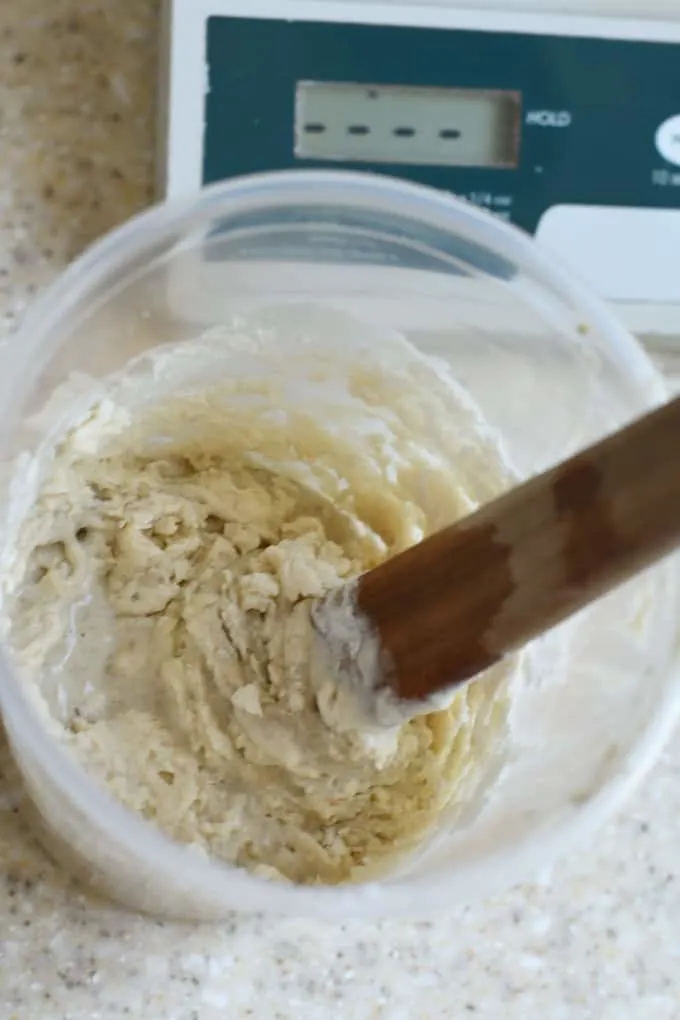
Right off the bat I’m going to say that there are a million ways to feed, maintain and use a sourdough starter. In fact, after you’re done reading this post, you should read through my instructions for How to keep a small sourdough starter to see of that method would work better for you.
I am going to outline for you how I maintain my sourdough starters. I tend to have a fairly relaxed attitude towards the process. It works for me and I think my approach can work for you if you don’t bake bread every single day (and even if you do).
At the end of the post you’ll find a how-to card that lists the ingredient amounts and steps to follow each time you feed your starter.
But first I’m going to give you all the how’s and why’s and try to answer any questions you might have.
Tips for using and maintaining your sourdough starter:
- Since I don’t bake every day, I keep my starters (yes, I have 3) in the refrigerator.
- If I’m making a 2-day recipe (most of mine are) I take the starter out of the refrigerator early in the morning of the day I’m making the dough. If the starter is inactive I feed it right away and it should be ready by early afternoon.
- If I’m making a 1-day recipe, I’ll take the starter out the night before and feed it if it’s inactive. It should be ready to use first thing in the morning.
- When the starter is cold from the refrigerator, I feed the starter using fairly warm water, warmer than body temp. The warm water will jump-start the cold starter.
- If the starter has been fed within the last 2-3 days, and has been refrigerated, you can probably go ahead and use it without feeding.
- If you’re not sure if the starter is active, drop a dollop into a bowl of water to see if it floats. If it does, it’s ready for baking.
- I write all my sourdough recipes to use 8 oz of active starter. After using 8 oz of starter in the recipe, I’m left with 4 oz of starter, exactly the right amount for feeding.
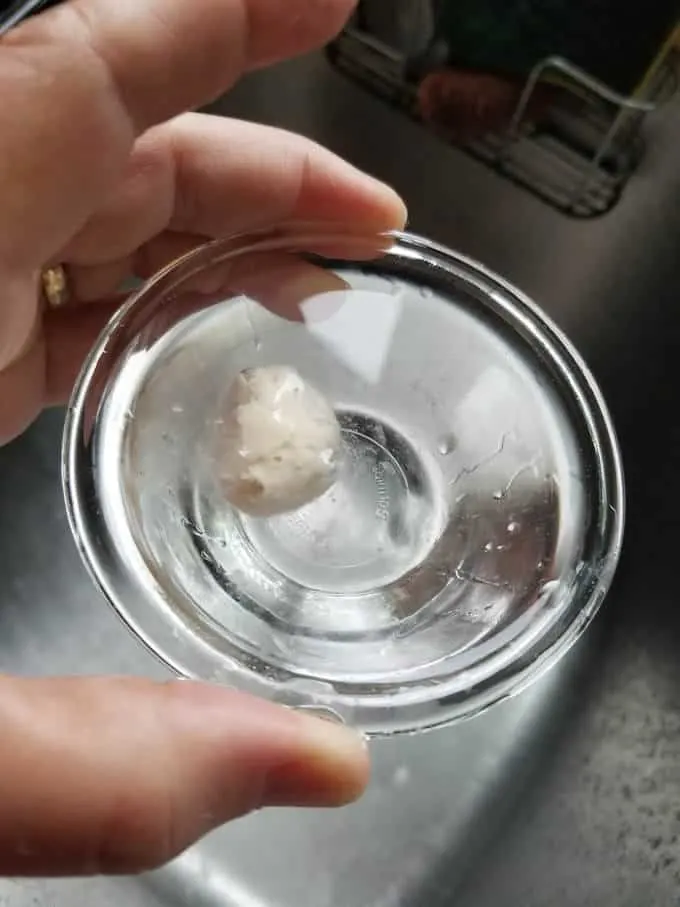
Schedule for feeding your sourdough starter:
- Your starter needs to be fed about 1x per week if refrigerated, and every day if left at room temperature.
- Generally, about 5-6 hours after feeding my starter is ready. The time may vary based on room temp, dough temp, etc. The starter should have doubled in volume and started to recede and/or pass the float test.
- I take my starter out of the refrigerator once a week for feeding, even if I’m not baking. Although, truth be told, I often go longer than a week between feedings and I haven’t killed it yet.
- Did you know you can dry your sourdough starter? Dried starter can be kept indefinitely.
- After you’ve removed the portion of starter for baking, feed the starter again and leave it at room temperature for 3-4 hours before putting it back in the refrigerator.
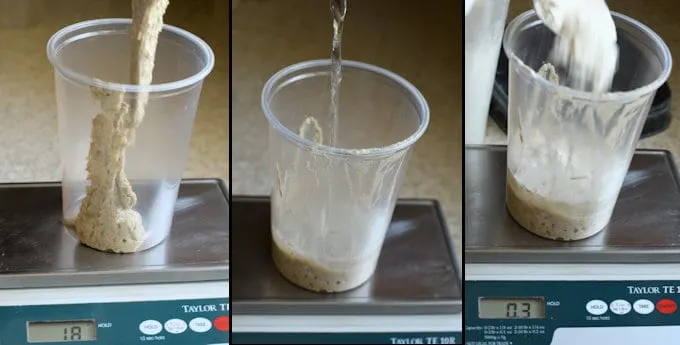
FAQs about feeding & maintaining Sourdough Starter:
Honestly, I’ve gone longer than a month without feeding my starter and I haven’t killed it yet. Give it a feeding and see if it wakes up. If it’s alive, keep feeding it until it is reliably doubling in size within 4-5 hours.
If you go more than about 2 weeks between feedings, you might want to give the starter 2-3 feedings before using. A starter that hasn’t been fed for weeks will be quite sluggish and your dough won’t be as lively.
If your starter was fed a day or two before, it’s possible to use the starter straight from the refrigerator. Give it a float test to make sure it’s active. The dough may take a little longer to ferment since the temperature of the dough will be colder.
It’s called “hooch” and don’t worry, your starter is still alive. Just stir that water back into the starter before feeding. Again, you might need 2 feedings to completely revive the starter since it’s been quite dormant.
To maintain your starter at 100% hydration it is best and most accurate to weigh your ingredients. If you’re just a little bit off every time you feed, eventually, your starter could be thrown out of balance.
No problem, use the amount of starter called for in the recipe. Then weigh out 4 oz of the remaining starter for feeding and discard the rest.
If you continually feed the starter without discarding, you’ll end up drowning in starter.
Yes, even if the discard is not active enough for baking bread, you can add it to many other recipes as a flavor and texture enhancer.
Unless you’re going away for an extended time, your starter should be just fine for a couple of weeks in the refrigerator. If you’ll be gone really long-term, put the starter into the freezer or dry it. Frozen or dried starter will need several feedings to rejuvenate.
If you appreciate this detailed information, I’d really appreciate a 5-star review.
How to Feed Sourdough Starter
Ingredients
- 4 oz unfed sourdough starter
- 4 oz all purpose flour
- 4 oz water (room temperature)
Instructions
- Weigh 4 oz of your unfed starter into a clean container. Discard the extra starter (see note)4 oz unfed sourdough starter
- Add the flour and water and mix until combined. Set aside at room temperature.4 oz all purpose flour, 4 oz water
- The starter is ready to use when it has doubled in volume and a small spoonful floats when dropped into a bowl of water. This generally takes 4-5 hours but the time can vary based on dough temperature and room temperature.
- If you do not plan to bake with the starter on the day it is fed, refrigerate 3-4 hours after feeding.
- Feed refrigerated starter weekly. If you go longer than a week without feeding, you may want to give the starter two feedings before using.
Would you like to save this recipe?
As an Amazon Associate and member of other affiliate programs, I earn from qualifying purchases.

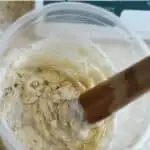





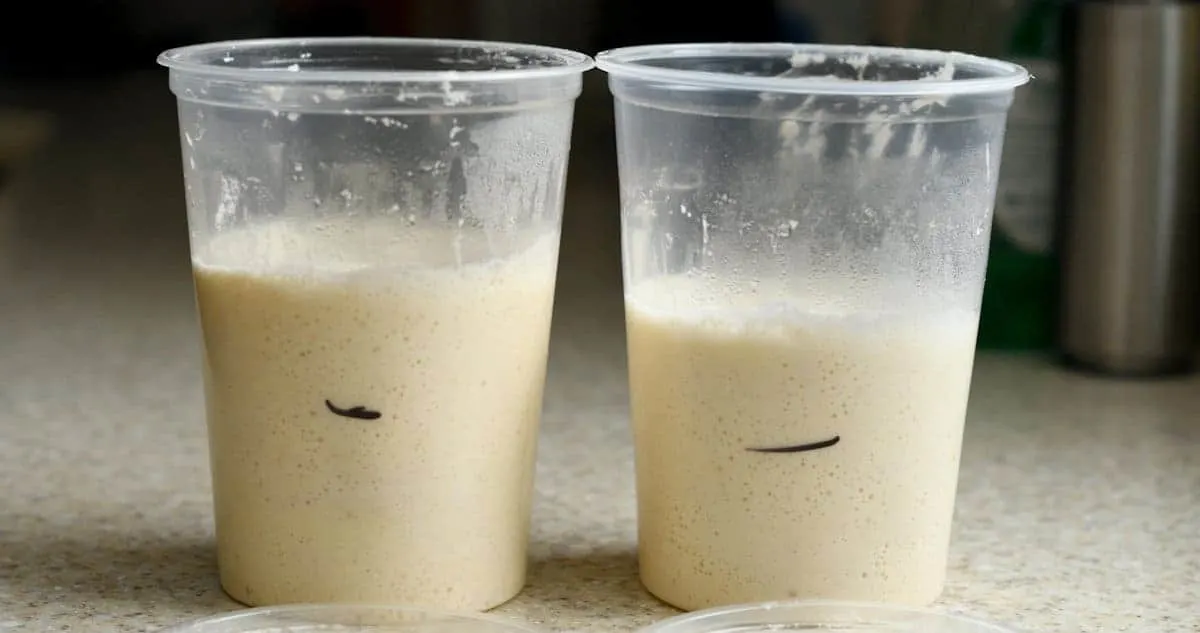
I have a starter that is bubbly, is nearly overflowing the jar on day4 which seems early to me. Do I continue to feed? And for how long? Or is it time to do a float test and be able to bake or refrigerate until I am ready? Thank you for your help.
I would give it a few more days. Even though is it bubbling you want to give it a few more days to get the nice yeasty aroma. You want the right balance of bacteria and yeast before baking with it. Have you read through my How To Make A Sourdough Starter post? You’ll see day by day photos and notes on the activity and smell.
Eileen, your site is great. Like many people I recently created a starter. I made your overnight cinnamon buns and was so thrilled when they rose and filled the pan without added commercial yeast. I’m confused about the term “100% hydration “. I made the sourdough bloodies ( they’re in the oven). You state you had good results from a starter that had been in the fridge a week. The recipe calls for 100% hydration starter. I don’t know if I was supposed to feed it or not before using. Thanks for any clarification.
100% hydration refer to how the starter is fed. The percent expresses the relation of the amount of liquid to the flour. So 100% means the starter is fed with equal weights of flour and water. If you have 80% hydration that would mean you have 80 percent flour to water, e.g. 8g of water and 10g of flour. The Sourdough Blondies use the “discard”. That is the stuff you throw away when you need to feed your starter. “Discard” recipes like the blondies give you the opportunity to use up that stuff rather than throw it away. Since my starter had in the refrigerator, unfed, for a week the flavor was pungent and sour. I like how that comes through in the blondies.
Absolutely love reading your tips and I will surely try your recipes too. I have just started my yeast starter with 4tbs flour and 3 tbs water and it’s been 6 days already. I did the float test and it was successful. It’s tripled in size and very happy . But I’m a bit confused on how to carry on feeding my yeast from now on. I intend to bake in 2-3 days and would use 3/4 of the yeast
mixture . I would leave a 1/4 in the jar and
would you be able to tell me how to proceed to keep it active . How much flour and water do I use and also can I keep it on my kitchen counter as I intend to bake on week ends. .
Thank you ever so much!
Read this post about growing your starter and you can also read this post about keeping a small starter.
So glad I found your site! Great resource.
How do you know if your starter is out of balance?
By out of balance I mean that it’s not made up of equal weights of water-flour (100% hydration). But there are plenty of folks who keep a wet starter that is more water than flour and some people keep a stiff starter that is more flour than water. If you have a wet or stiff starter you just need to account for that when mixing the dough. Since my recipes are all written for a 100% starter you would need to adjust the ingredients to accommodate your starter. Do you already have a starter? Did you make it or did someone give it to you? If the starter has the texture of a very thick pancake batter it’s probably a 100% hydration starter.
Thanks! I was recently given my starter (it’s been in her family for years) and I assumed I should feed 1:1:1. But it’s become watery, doesn’t double and separates within 24 hours. I read your page and I think I’ve unbalanced it. It still bubbles but isn’t as active as before.
Do you feed 1:1:1 by weight or by volume? 1/2 cup of water is 4 oz but a 1/2 cup of flour is 2.5 oz. So if you use volume measure you will have a looser starter. Nothing wrong with that, but it may need to be fed more often.
Thanks for your reply! It rises about 25% from what I can see. It failed the float test though. Do I continue feeding it everyday in the hope it will rise more?
I would keep feeding it until it’s quite active. Are you using unbleach ap flour for feeding? You can try to give it a little whole grain rye or wheat flour. Sometimes the starter likes the whole grain for an extra boost.
My starter has finally doubled earlier this evening! hooray. But I can see it collapsing as it doubled a couple of hours ago. Do I need to feed it again to keep it active until i’m ready to bake, which is some point this weekend?